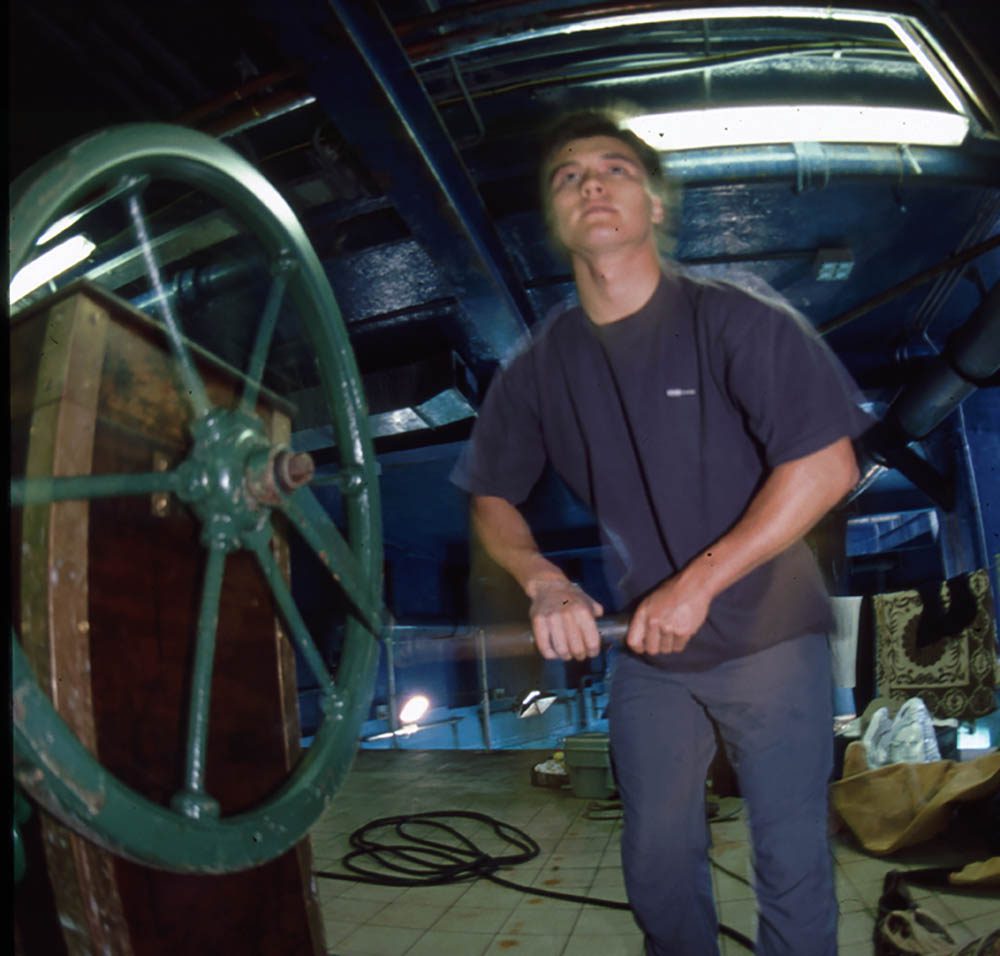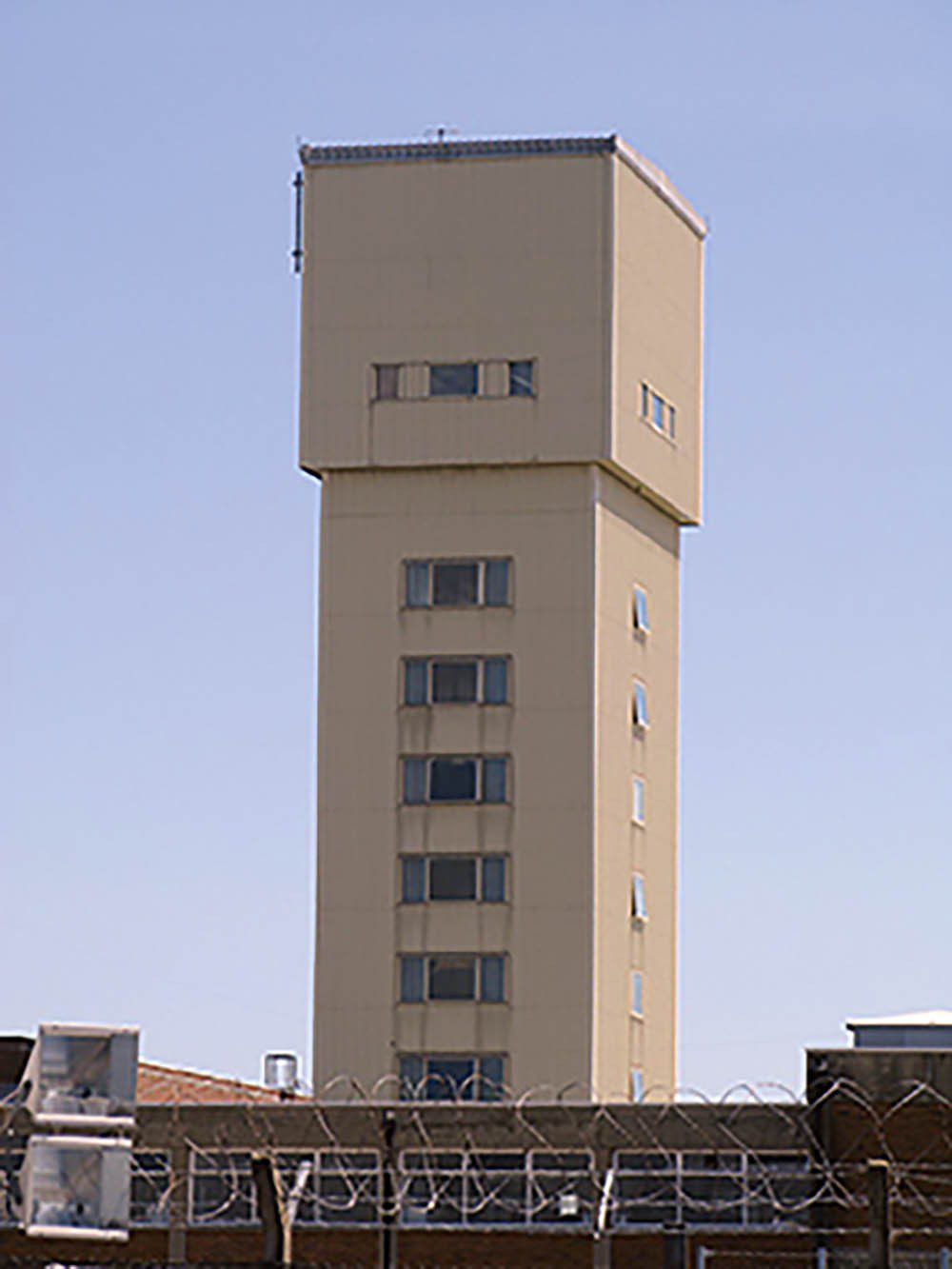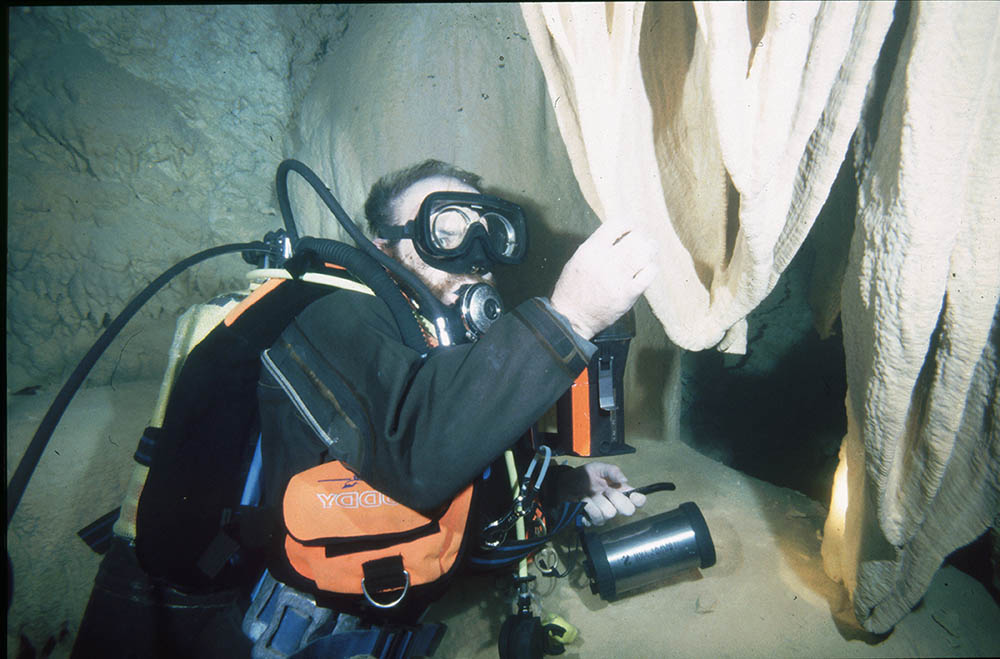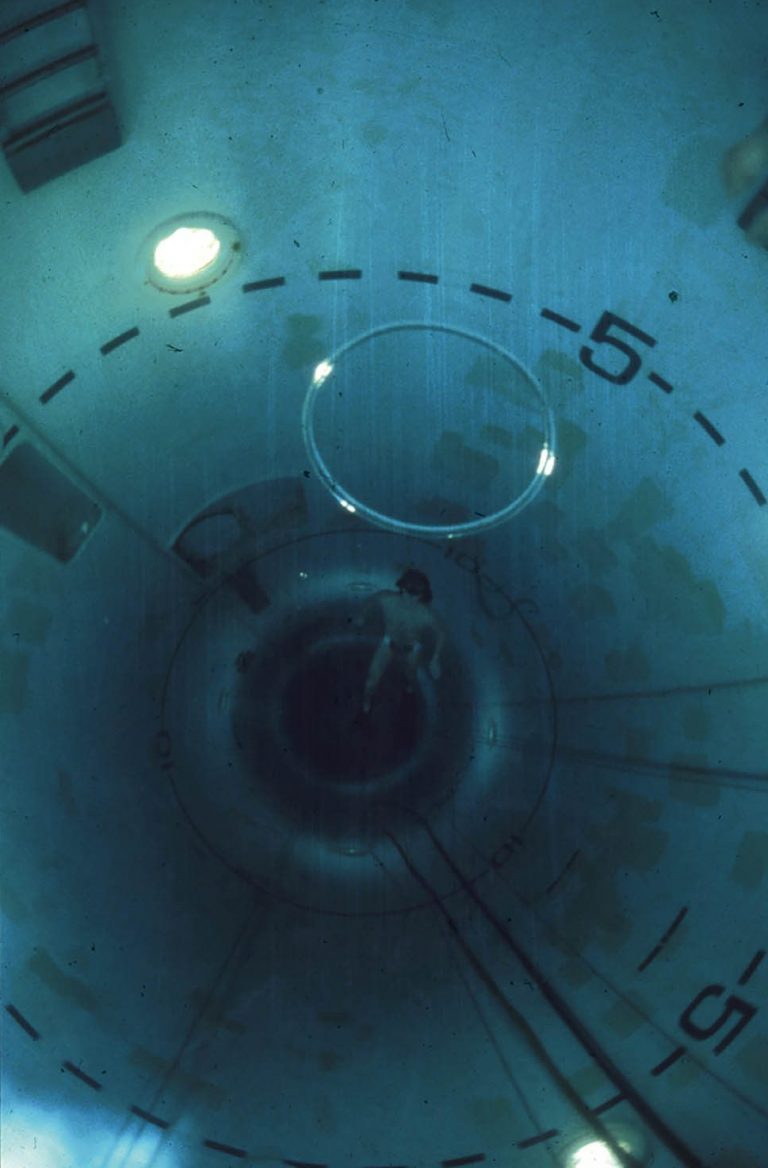HIDDEN DIVER
The Atlantic Tank, the SETT and the Silent Pool – all three are now defunct dives, and all left lasting impressions on STEVE WARREN
Also Read: U-boats & special forces star at HDS conference
THERE’S A MERMAID alongside me, but I ignore her. I’m nearly 30m down, but this is not the onset of narcosis. My mask seems to flatten onto my face. I’ve nothing left to exhale into it. It won’t equalise.
I high-five a steel hatch, right myself and look up through a giant Smartie tube towards the surface. This is the Submarine Escape Training Tower, and I’m on a freediving course. I’ve just made my deepest-ever snorkel dive.
The problem is that it’s my deepest descent by about 2m too many, which, I realise with resignation, means that the ascent is going to be a tad tricky.
SETT is one of three indoor dives I’ve come to cherish, all the more so because they can’t be done any more.
But my story of diving behind closed doors begins in central London, less than a mile from the Houses of Parliament…
“MAKE LIKE A TORTOISE” instructs Adrian Barak. I tuck my chin in, and Adrian and Peter Wingett hoist the brass diving helmet over my head and settle it onto the breastplate.
Adrian and Peter are two of a band of enthusiasts who celebrate the exploits of helmet-divers of old. In a re-enactment of diving standard dress, the Historical Diving Society is mounting a display at the old London Aquarium.
With a sharp quarter-turn the helmet, or hardhat, locks onto the neck-ring.
Air pulses gently in from a hand-pump behind me, to which I’m linked by a thick coiled hose. It’s driven by two other stalwarts of the HDS Working Equipment Group (South), who idly spin the stagecoach-sized wheels to ventilate the suit and keep me cool.
The faceplate is screwed into place and I’m ready to dive – if I can just stand up. Over the canvas drysuit, chest- and back-weights have been strung. The boots are also weighted. All up, a set of hardhat equipment can top 90kg – no wonder the Americans call this “heavy gear”.
I’m helped to my feet and lurch forward. I’m about to step back in time – the equipment I’m wearing is nearly a century old.
I clumsily descend an aluminum ladder from the dive-deck into the cool waters of the Atlantic tank. As the water swirls over my head, the weight is literally lifted from my shoulders as the air-filled helmet becomes buoyant.
The air drones around my ears to the rhythm of the pump, nothing like the rasp of an open-circuit regulator.

Before the invention of the motorised air-compressor, manpower alone forced air down to the diver below against the opposing water pressure. As depth increased, the size of the teams working the pumps got larger and they would have to be rotated more often, such was the physical effort required to support a single diver’s excursion.
Each footstep chimes out through the water as leaden soles strike the metal ladder-rungs. On the concrete floor I find my footing. The equipment, so unwieldy topside, assumes a certain grace under water. I walk in slow motion, head bowed.
The helmet has four windows or lights – one in front, two at the sides and the last in the front top.
You quickly learn that turning your head to look at something is unlike using a normal face-mask. Inside your helmet your head twists, but the helmet doesn’t, so you peer out of the nearest porthole.
Hunched over, you move ahead looking through the top light. To demist the faceplate, a lever-operated valve called a spitcock lets you suck in a little water and splash it over the window-panes.
Light in the head and heavy on your feet, you easily stay upright. The air flows in and out of the helmet and drysuit constantly, bringing oxygen and flushing away carbon dioxide.
Before the drysuit was invented and joined to the helmet to create the fully watertight or closed dress, a diver who stumbled could flood the helmet and drown. Legend spins tall tales of divers’ skeletons being crushed into their helmets and their soft tissues squirting up their breathing hose in the event of an accident, such as falling off a cliff or a hose rupturing or a pump failure.
In reality a fall was dangerous, because the suit would shrink-wrap around the diver, just like an unequalised modern drysuit, and hamper breathing.
A break in the hose was much more serious so, eventually, check-valves were installed where it connected to the helmet. In the event of a hose rupture, this held back air that could be breathed briefly,
and prevented a dangerous loss of suit-pressure and a lethal inrush of water.
An adjustable valve in the helmet, similar to a modern drysuit’s auto-dump, is used to control the diver’s buoyancy.
Divers would normally have worked on the bottom and been hauled to the surface by their lifeline, or lowered and raised or made decompression stops on a suspended platform or stage, hence the term stage decompression. Dive-tables appeared only in 1908, nearly 100 years after divers started getting bent.
None of this would have needed much in the way of buoyancy skills, but HDS members like Adrian have mastered the ability to hover perfectly in midwater anyway. It’s quite an act.
IN A DIMLY LIT AREA of the tank there are congers. I trudge over, carefully guiding my hose and lifeline, with its integrated telephone cable, around a decorative pillar, mindful of where I place my boots for fear of further flattening a flatfish, or turning a crab into so much shrapnel.
I crouch, cradling an eel in my arm.s. “Entertain the kids!” comes the admonition from Cheryl Hugil, a stern lady who is not to be trifled with. She sports a baseball cap presented to her in awe by America’s hardline DEA (Drug Enforcement Administration).
I move around the tank, waving at the weekend crowd. Parents hold their children up against the windows, some energetically waving the hapless kid’s hands back at me.
Through the glass I can see the wonderful display of diving helmets the HDS has set out. There is something charismatic about the equipment, and romantic about the frontiersmen who submerged to construct harbours, salvage lost cargos and harvest pearls wearing it.
Incredibly, barely modified hardhat equipment was still in use at Royal Navy dockyards in the 1980s, 150 years after Royal Engineers had used it to demolish the wreck of the warship Royal George, which sank obstructing Spithead harbour.
The endurance of hardhat equipment was testimony to both its practical design and the duration and safety surface-supplied air provides.
To my surprise, I find that the equipment I am wearing, worth thousands of pounds but impossible to value in legacy, is owned not by the HDS but by its individual members. It’s heavy and tricky to haul through the labyrinthine corridors of the aquarium to the tank, and time to dive it is short, so their generosity in allowing it to be dived can’t be overstated.
Even the younger HDS members supporting the crowd-pleasing exhibition are mostly in their 60s. Among those diving is an 80-year-old who, having won medals for valour as a frogman-saboteur in WW2, is reputed to be especially proud of his Blue Peter badge.
It’s humbling to observe the ease with which the veterans handle the equipment out of the water.
I watch a 30-year-old friend paw the air like a bull as he struggles again and again to swing his leaden foot across the tiny gap between ladder and decking. It’s technique that counts. We have none.
BEFORE THE INVENTION OF surface-supplied diving in the 1820s, depth and duration was limited by how long divers could hold their breath.
It takes around half an hour to change out the hardhat divers, even with two tenders dressing and dekitting them. During the gaps, Andrew (AJ) Pugsley and I amuse the crowds by snorkelling. Funny how, once a person enters a tank stocked with exotic marine life, the spectators’ fascination turns towards the human.
We’re using freediving suits. Inside they are unlined neoprene and normally we use soapy water to slip into them but here, fearful of the consequences of killing the fish, however cleanly, we’ve made a side trip to Boots.
Parents continue to hold their toddlers up to the glass, encouraging them to grin and wave at us. I wonder what they’d think if they knew that, under our camo-patterned rubber suits, we are liberally coated in KY Jelly.
We lounge on the bottom, pushing times of two minutes or so. We look relaxed, making it seem easy, but we’re faking. The public lose sight of us as we ascend, not seeing the state in which we actually hit the surface.
On the outside of the tank, AJ’s then-girlfriend overhears a comment made in unbridled astonishment. “Those guys are incredible. That tank must be 15m deep!”
“No,” Kate corrects him needlessly, “it’s only four.”
ON THE FLATLANDS of Gosport, not far from where the Royal George foundered, a single high-rise building stands tall near HM Naval Base, Portsmouth. The Submarine Escape Training Tower was built in the 1950s, and thousands of submariners learnt emergency escape procedures there.

It’s strange to take an elevator ride to your dive-site, the ultimate high entry.
The digital display slowly counts off the floors. At floor 10, the door opens onto an 8m-diameter pool.
At first it looks much like a cheap portable circular pool that you might place in your garden, but glance over the edge and it simply drops away. The water is gin-clear, tinged green by lights lining the walls, and 30m below me I see the steel base. It’s a long way down. I’m entranced.
Howard Jones is my freediving instructor. Before he emerged onto the breath-hold diving scene, the activity in the UK had mostly been restricted to spearfishers, but he had evangelised freediving, the parkour of diving, showing that it could be both competitive and meditative by turn.
Boosted by a primetime BBC documentary that had aroused interest in the sport beyond the diving fraternity, Howard found himself cast in the role of guru. He has gambled on hiring the SETT this weekend, and it has paid off.
Alongside AJ and myself, experienced snorkellers about to progress our training towards the longer, deeper dives we will later rely on for filming orca and pilot whales, are people who have never even snorkelled in the sea, drawn in by TV.
Others are technical divers abandoning their rebreathers and multi-gas stage bottles for a simple snorkel. And there are the British champion freedivers, plunging to the bottom to refine their techniques in search of future medals. Lee, one of the best, keeps taking fag-breaks.
We begin our dives. A clean duck-dive sends me under water. There’s no need to fin. As pressure collapses my lungs, I lose buoyancy fast.
Like a raptor falling from the sky,
I assume a steep attack angle, hands clasped behind my back, knees and ankles locked together to maximise streamlining and pick up speed.
It’s exhilarating. In open water, when I was young, fit and snorkelling several times a week, the deepest I’d ever reached was 18m. Here the water is so warm that swimsuits can see us through the day’s six hours of training and practice, and within a few dives I’ve passed the 20m mark, indicated by big numbers on the tank wall.
A little deeper is the lovingly painted mermaid. And, just beyond, the tank floor with its escape hatches through which the submariners enter the SETT, carried aloft by inflated survival suits. My confidence has turned to over-confidence, and I become fixated on reaching the bottom.
IF THE DESCENT IS effortless, the ascent is not. Near the bottom I weigh several kilos. A steel hawser runs down the centre of the tower. Escaping submariners are hooked to this for their 60-second joyride to the surface. We can use it to drag ourselves upwards hand over hand.
The difference between climbing the cable and finning, even equipped with the metre-long signature fins of the serious freediver, is considerable.
A SETT instructor gently mocks the hi-tec the freedivers have brought to the course: fins with blades of carbon fibre and masks filled with saline, which allow the diver to see but eliminate the need to waste valuable air on equalisation.
“All I’ve got is my Speedos and goggles,” Denzel jokes. The SETT instructors tend the escapees and easily work on the tank floor. Small collapsible air-bladders on their goggles automatically inject air, equalising them as they descend.
Breath-holding prolongs the time the tenders can spend at depth, compared to the decompression penalties that working for long periods at 30m, even on nitrox, would impose.
While we pause our breathing, our bodies are depleting our stocks of oxygen and generating carbon dioxide. It is not the falling O2 that triggers the stimulus to breathe, but the rising CO2.
Breathing techniques used by breath-hold divers slightly reduce CO2 levels in the blood, prolonging the time it takes to trigger breathing. There’s also a line, somewhat woolly, between ignoring a little discomfort from building CO2 and increasing the risk of a shallow-water black-out from a dangerous drop in O2.
During descent pressure collapses our lungs, driving more oxygen into our circulation, which we can use to lengthen our dive to some extent. CO2 builds up as the oxygen is metabolised and begins to nag us to breathe.
As we ascend, pressure drops, our lungs reinflate and oxygen begins to return to them and leave our circulation, where it is most needed. At the same time, CO2 levels fall, and the urge to breathe reduces and may even disappear altogether. But the body’s need has not gone away.
Feeling a once-urgent trigger to take that next breath recede is an indicator of impending trouble. Many breath-hold divers have lost their lives by pushing slightly beyond their limits just once.
As I rise from the bottom towards the surface, my own urge to breathe fades a little. Now I have to reach a compromise.
If I fin slowly, I’ll deplete my remaining O2 more gradually than if I fin quickly, which takes more effort and consumes more oxygen. But it will take longer to reach the top, and my next breath.
The risk of blacking-out increases with each centimetre I ascend. Pragmatically, I steer towards the largest group of people, far, far above me.
AJ describes what happened next: “Steve is heading towards the surface, near where I’m holding onto the side. Howard is on the other side of the tank, explaining techniques to other members of the group; still maintaining an eagle-eye, he sees Steve break the surface.
“Steve in that instant looks in control and takes a breath; Howard calmly but authoritatively issues the instruction: ‘Grab him!’ No sooner has that been done than Steve’s body goes totally limp, as, it seems, does his mind for a brief moment in time before rapidly recovering.”
As I recall, as I snatched that breath I felt a series of tremors run through my body like painless electric shocks.
It’s a samba. I’ve come within seconds of a total black-out. I don’t remember going limp or being grabbed.
That my recollection differs from what AJ witnessed is typical. In 45 years of snorkelling in open water I had never pushed myself so far, but at SETT I’ve been seduced by depth.
The lesson learned is a harsh one.
THE ROCK OF GIBRALTAR is honeycombed with natural caves formed through millennia, and man-made tunnels hewn by the British military over the past three centuries.
Behind an unimposing gate in one of the defensive walls that rings the city lies a subterranean road set within a concrete-lined tunnel. Add Mini Mokes and men in jumpsuits and it could easily be straight from a Bond set.
Sitting in the back of an Army Land Rover, my feet resting on my cylinders, we drive a kilometre, then stop beside a house. Bond now turns to Alice in Wonderland.
As the front door is thrown open and the lights are flicked on, a grotto with a small glassy lake is suddenly revealed.
I’m making this dive at the invitation of Phil Smith, Diving Officer of 317s, a BSAC Special Branch attached to the Gibraltar Joint Services Sub Aqua Diving Centre. Lying within secured military grounds, the cave-dive is otherwise strictly off-limits.
Silent Pool Lake is the placid entrance to an underwater tunnel stretching more than 100m and bottoming out at 42m. It forms part of the huge Ragged Staff cave system.
The grotto is becalmed and beguiling, but cave-dives are the most dangerous of all dives, and this one has already killed.

I’m not cave-trained, but I have just read Sheck Exley’s Blueprint for Survival, which pointed out that the most likely individual to die cave-diving was an open-water scuba instructor. Such divers had the necessary arrogance to think that they could beat a cave without the required training, and often lost the bet.
Chance rarely came into it. In a cave filled with water, you don’t have to be unlucky to die; you need to be lucky to survive – or a respectful and well-trained cave-diver. As an open-water instructor, I found myself dwelling on this.
Dennis Santos helped to place the permanent lines into Silent Pool that each buddy-pair will follow. Although lines had been set before, they were confusing, making it easy for a diver trying to exit to swim further into the cave by mistake.
Sediment covers the bottom. A careless fin-kick can quickly turn visibility to zero.
The commonest cause of death in a cave is no more complex than failing to surface before your gas runs out. If divers get lost or misjudge how long it will take to exit, time is not on their side.
Getting lost is how the Navy diver came to die in this very simple cave system. Dennis, a hugely experienced diver, knows how fickle fate can be. “I went in to explore beyond the limits of the existing permanent guide-lines,” he told me.
He chose to use a roped-diver arrangement adopted from commercial and military diving, with a tender on the surface paying out line as he and his buddy penetrated the chasm.
“We wanted to see how far the tunnel extended. We passed the previous lines limit at 30m depth and pressed on.
“As the tunnel walls, ceiling and floor converged, we found another small cave. It had just enough space for us to enter and that was it – we could go no further.”
The pair were now in an alcove. Dennis had intended to use pulls and bells – rope signals – to communicate with his tender, but the line had snagged on the buckle of Dennis’s fin and his tender had mistaken the tugs he felt as Dennis finned for an instruction to pay out more rope.
Pulling on the line to get enough slack to tie off, Dennis suddenly found the line wrapping itself around him and his buddy. They quickly shrugged it off and turned to follow the line back towards the safety of the surface.
He was confronted by a cat’s cradle of rope blocking the only way out.
“I just saw coils of line, and I knew we couldn’t follow it without getting even more entangled. Visibility was rapidly closing in, and suddenly I couldn’t even see how to get us both out of the chamber. Our lights were reflecting off the silt and blinding us.
“I began to think we wouldn't survive.
I felt my breathing accelerate and I got mixed signals of apprehension building towards panic, and thoughts running through my mind about my friends and family, and how utterly stupid it was to die like this.
“I became resigned to dying and it actually had a calming effect on me. I was sitting on the bottom and slowly realised that my bubbles were heading up and away from me along the roof.” It was the cue Dennis needed.
“I knew those bubbles were heading upwards towards the exit. They had no choice. I followed them, even though I could barely see even a few centimetres.”
The bubbles were pooling in the ceiling. New ones arriving caused an overflow, and the displaced bubbles would trickle out and move a little further along the roof.
“We got out of the alcove. Our own line was such a mess I didn’t trust following it, but I knew that to our right was the permanent line we’d left behind at 30m.”
Missing this line could easily have proven fatal. Beyond it, Silent Pool branches off into a confusion of dead ends. Fortunately, visibility improved outside the alcove and Dennis located it in the sweep of his light. Back at the surface, their pressure gauges confirmed how close a call it had been.
As Nick Balban and I descend, “okaying” the permanent guideline between thumb and forefinger to ensure maintained contact with it, I’m substantially overweighted. The water is fresh, and I’m balanced for salt.
Air shifts awkwardly inside my suit. Once this cave was dry. Beyond even the merest spark of sunlight, and before the cave flooded, a stalactite and stalagmite had joined up to form an imposing limestone pillar.
The line is belayed around it and, ignoring two other ropes leading off into shallower recesses, including the 30m line that led Dennis to safety, we follow the deep line angling down the slope. It quickly fades to black beyond our lights.
The pale tunnel walls and ceiling begin to narrow. A little deeper and my vision begins to swim. Nick’s body seems to shimmer as if in a hall of mirrors.
I start to become buoyant, and raise my bicep to dump air. We’ve just passed through a halocline, leaving fresh water above and behind and pushing forwards and ever deeper through sea water.
The fresh water is rain, made clear and laced with calcium as it filters through the limestone. Saltwater permeates through the rock lower down as Silent Pool winds its way below sea level.
The cave had been thought lifeless, but Andrew Bell discovers and videos some tiny and nearly transparent shrimps. Nick, leading, runs his fingers through a crevice at the farthest and deepest point of our dive, just shy of 40m. We’re just outside the small cave where Dennis nearly died.
We turn and head back, through water dotted by descending particles brought down from the ceiling by our exhalations.
Each subsequent team will have to cope with deteriorating visibility. Off to one side we pause to admire the Curtains, a rack of stalactites that screen off another alcove etched into the limestone.
We make our safety stop within sight of two high-power lamps overlooking the grotto. When Dennis got into trouble, there were no such safety markers. Our bubbles rise to follow the roof towards the lights, where they’ll noisily break surface, just as Dennis’s did all those years before. Soon, reluctantly, we’ll do the same.
Silent pool is, perhaps, Gibraltar’s most secret cave. Now, for safety reasons. it is no longer dived. SETT became superfluous to the Navy and has been closed. Under Sealife’s management, the London Aquarium Atlantic Tank has been transformed into a walk-through exhibit full of sharks, turtles and rays.
These dives are now consigned to my history, fondly recalled as I flip through images and remember good times with old friends. The doors have closed, and there’s no going back.

